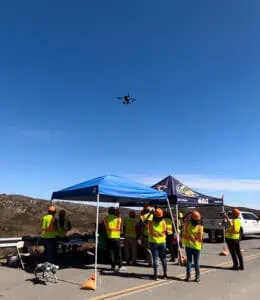


Orange County Waste & Recycling (OCWR) hosted a landfill tour showcasing technologies used at the Frank R. Bowerman Landfill as part of the August California Resource Recovery Association (CRRA) Conference & Trade Show. SCS’s Remote Monitoring & Control (SCS RMC) demonstrated advanced technology that protects neighboring communities, workers, and the environment from methane naturally produced as waste decomposes.
Landfills use complex systems to achieve the appropriate balance and tuning of the gas collection and control system (GCCS) at a sufficient extraction rate. The rate optimizes the effectiveness and efficiency of the GCCS to minimize fugitive LFG emissions while simultaneously preventing air intrusion caused by overdrawing wells. The collection and control process minimizes the migration of subsurface gas and odors while operating in accordance with federal, state, and local air quality regulations and air quality permit requirements.
Each landfill is unique, but these new technologies can also help protect a landfill’s bottom liner and final cover systems by controlling the accumulation of pressure due to the presence of LFG within the waste mass. Landfills collecting LFG as fuel for a landfill gas-to-energy facility or renewable natural gas plant can better maintain high gas quality. Where applicable, the technologies can help remove heat to contain and manage subsurface reactions in elevated-temperature landfills.
At the OCWR Landfill Tour, there was much to monitor and measure, including operational parameters such as pressure, temperature, gas composition, flow rate, and liquid levels at individual wells. Collecting this information at each well is time-consuming, expensive, and sometimes difficult to collect on foot. SCS RMC demonstrated the evolution of technologies enabling continuous and remote collection and measuring multiple parameters in real-time with automated wells.

Evelyn Martinez scanned the demonstration area for LFG using a drone, demonstrating how drones quickly collect methane data to detect anomalies. A monitor displayed real-time drone data collection, and a second monitor showed real-time flare station data and past methane drone scans of the landfill.
Omar Rodriguez and Marco Quen demonstrated handheld methane detection instruments using optical, thermal, and other sensors and how automated wellheads utilize in-line sensor technology and do not require pulling a gas sample into an analyzer sensor. There was also an odor monitoring and reporting station, and the technology guru Phil Carrillo brought his robodog.
About OCWR
OCWR manages one of the nation’s premier solid waste disposal systems, serving residents and businesses in the County’s 34 cities and unincorporated areas. The three active landfills, including the Frank R Bowerman Landfill, reflect environmental engineering at its best and are among the largest in the state – annually receiving more than 4 million tons of solid waste.

These state-of-the-art facilities take pride in being good neighbors. The landfills use sanitary and environmentally friendly operational methods and advanced technologies that have earned them multiple awards for their modern management techniques, regulatory compliance, and environmental practices, including noise reduction and visual screening techniques, natural habitat planting and re-seeding, the use of falcons and hawks to reduce the number of scavenger birds, and weed abatement provided by real goats.
OCWR currently operates greeneries in Irvine, San Juan Capistrano, and Brea. The full-circle recycling program starts with curbside residential collection of green and organic waste transformed into high-quality compost and mulch and returned to the community as a free resource to enrich gardens and landscaping. Composting helps reduce greenhouse gasses and preserves future landfill capacity.
OCWR’s Renewable Energy Program manages the beneficial reuse of landfill gas through power-generation partnerships that produce 380,000 megawatt-hours of electricity annually.
The SCS RMC team sends thanks to OCWR for helping to educate the public, agencies, and the waste management industry on the benefits and uses of modern landfill technology at work!
Landfill Technology Resources: